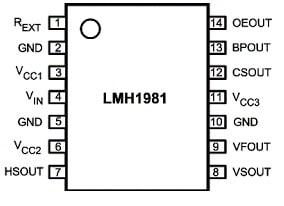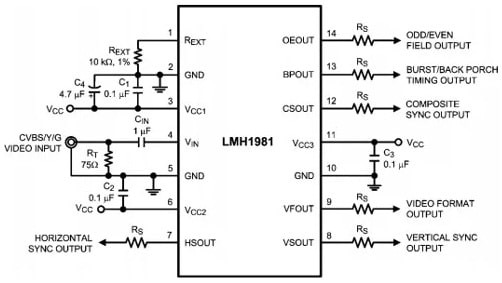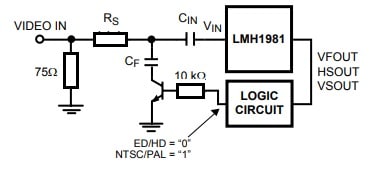A sync separator or a multi-format video sync separator is a device that extracts timing data from video inputs and generates sync signals mainly for video systems. This sync separator detects the input video format and separates synchronous signals for typical & high-definition video formats. So it generates low-jitter vertical and horizontal sync signals to provide timing outputs mainly for video systems. The applications of sync separators include; professional and broadcast video equipment, Genlock circuits, HDTV/DTV systems, Set-top boxes, recorders, video capture devices, etc. Examples of multi-format video synchronization separators are LMH1981 IC, EL1881 IC, etc.
What is LMH1981 IC?
The LMH1981 IC is a multi-format video synchronization separator that operates from a 3.3V to 5V voltage supply range. This IC is available in 14-pin SOIC & PDIP packages which are designed to be used within video applications for dividing synchronized signals from quick and irregular video signals. In addition, this IC can also allow various analog input formats like SD/HD//ED and also detects the video signals format.
This video detection feature is helpful because we will not require any microcontroller. This IC is suitable for video equipment like professional video systems, broadcast & DTV/ HDTV applications; essentially. It separates the sync data from the complex video signal to give accurate timing data mainly for video processing in a system.
The input accepts normal analog SD/ HD/ ED video signals with either tri-level or bi-level synchronous and provides all of the significant timing signals within CMOS logic, So it swings from rail-to-rail like composite, vertical and horizontal syncs, odd/even field, burst/back porch timing & video format outputs.
The LMH1981 IC detects the input video format automatically by removing the requirement of programming with a microcontroller. So it applies exact 50% sync slicing to ensure precise synchronous extraction at OH, even for inputs with unequal amplitude from unacceptable termination (or) transmission loss. Its unique video format output expresses the whole horizontal line count for each field like an 11-bit binary serial data stream. So it can be decoded through the video system to decide the input video format and allow dynamic change of system parameters like scaler conversions or color space.
How LMH1981 IC Work?
The LMH1981 IC works like a multi-format video sync separator which means it separates the vertical & horizontal synchronization signals from a composite analog video signal. So it detects the input video format automatically & provides exact timing data in video systems for further processing like capture devices & displays. It can also allow a system to precisely interpret & display video signals by dividing the picture information from the timing data embedded in the video signal.
First, the LMH1981 IC gets the composite analog video signal on its input pin. After that, the IC analyzes the video signal internally to recognize the sync pulses in the video signal. So it separates the horizontal & vertical sync signals from the complex video data. So this IC determines the video format depending on the sync pulse characteristics. Finally, the LMH1981 IC provides the separated vertical and horizontal output sync signals with the video format data all within a clean CMOS logic level.
Pin Configuration:
The pin configuration of LMH1981 IC is shown below. This IC includes 14 pins total where six pins are output pins. So each pin with its functionality is discussed below.

LMH1981 IC Pin Configuration
- Pin-1 (REXT): An external resistor responsible for establishing the internal bias current and precise reference voltage
- Pins – 2, 5 & 10 (GND): It is a ground pin that is connected to the GND of the circuit
- Pins 3, 6 & 11 (Vcc1, Vcc2 & Vcc3): These are voltage supply pins of IC.
- Pin-4 (VIN): It is an input signal of the IC.
- Pin-7 (HSOUT): It is a horizontal synchronization output pin of the IC.
- Pin-8 (VSOUT): It is a vertical synchronization output pin of the IC.
- Pin-9 (VFOUT): It is a video format output pin that detects an input video signal’s format.
- Pin-12 (CSOUT): It is a composite synchronization o/p pin of the IC.
- Pin-13 (BPOUT): It is a Burst/Back porch timing o/p pin.
- Pin-14 (OEOUT): It is an odd or even field o/p pin.
Features & Specifications:
The features and specifications of LMH1981 IC include the following.
- LMH1981 is a multi-format video synchronization separator IC.
- This IC is available in both 14-pin PDIP & SOIC packages.
- It accepts both Bi-level & tri-level synchronous video inputs.
- This IC has in-built ESD protection mainly for inputs.
- It has different video format outputs like horizontal sync, composite sync, vertical sync, odd/even field, burst/back porch timing, etc.
- It generates a horizontal synchronous signal on pin-7 of the IC, that includes very little jitter on its leading edge.
- It detects video format automatically and 50% applies synchronization slicing mainly for video inputs which range from 0.5 VPP – to 2 VPP.
- This IC works from 3.3V to 5V voltage supply.
- The operating supply current will be 11 mAmps.
- This IC is well-matched with the Macrovision system, utilized within VHS & DVDs.
- It has standard analog video sync separation for PAL, NTSC, 480I/P, 720P, 1080I/P/PsF, and 576I/P from S-Video, composite video & component video interfaces.
- Its operating temperature ranges from -40°C to +85°C.
Equivalents & Alternatives
Equivalent LMH1981 ICs are; LMH1980, LM1881, EL4581, LMH1981, etc. Alternative LMH1981 ICs are; EL4583, EL1993, etc.
LMH1981 Video Sync Separation IC Circuit Diagram
The LMH1981 video sync separation IC circuit diagram is shown below. This IC needs fewer external components. This regulator IC is mainly designed to divide the synchronization signals using video signals. After that, it provides the vertical, horizontal & composite synchronization signals through the 7, 8, and 9 output pins and related timing signals within CMOS logic.

LMH1981 Video Sync Separation IC Circuit
Working
Here, pin-4 of this can be connected to an input video signal from CVBS composite, Y/C S-video, YPbPr component & computer interfaces. The significant feature of this regulator IC is that it can notice the input video signal format automatically and separates the signals that change with amplitude by providing a 50% slicing methodology.
Pin 9 video format output notices the input and states its format on the o/p pin. So it transmits a signal in the 11-bit binary data stream form that states the vertical resolution of the i/p signal. So this data stream can be decoded through a system to decide the layout. If the video format varies, then this pin informs us regarding the changes within a format so that the parameters of the system can be regulated.
The required external components used in this circuit at the power supply pins are bypass capacitors and at pin 4, an input coupling capacitor & a precision REXT resistor are used at pin 1. This IC’s operating voltage ranges from 3.3 to 5V. So the input pin is fed through a less-noise, broadcast-quality signal above 75Ω coaxial cable. To avoid unwanted signal distortion, the output video which is free of composite can be utilized on RGB monitors and can be attained from pin-8.
The pin 14 like OEOUT is an output signal pin that identifies even and odd fields of segmented frame video formats. When this output is high throughout an odd field & low for an even field. So it is always high for progressive video formats.
Optional Input Filtering
If the video signal contains considerable high-frequency noise (or) large chroma amplitude then an external filter is necessary to extend close to the sync tip. A simple RC LPF with an RS series resistor & CF capacitor to GND can be utilized to develop the overall S/N ratio. It attenuates chroma sufficiently such that the least peak of its amplitude can be higher than the 50% sync slice level. To get the preferred filter cutoff frequency, it is suggested to differ CF and maintain RS small to reduce sync tip clipping because of the voltage drop across the resistor. An external filter increases the propagation delay from the i/p to the o/ps.

Control Circuit with Chroma Filter
In applications where the chroma filter needs to be immobilized when the input is a non-composite video like ED/HD video. So it has the potential to utilize a transistor to open CF’s switch connection to GND. So this transistor will be turned on or off by logic circuitry to interpret the lines-per-field data o/p.
Advantages & Disadvantages
The advantages of LMH1981 IC include the following.
- The LMH1981 IC includes precise sync extraction, low jitter & automatic video format detection.
Video format detection can be done automatically. - It ensures precise sync extraction even for inputs through irregular amplitude.
- It reduces external circuitry required to clean and decrease jitter within subsequent synchronous processing stages.
- It is perfect to use in different video applications like broadcast video equipment, and professional video equipment & DTV or HDTV systems.
- They can convey the whole horizontal line count for each field like an 11-bit binary serial data stream.
- It can operate above −40°C to +85°C temperature range.
The disadvantages of LMH1981 IC include the following.
- The LMH1980 IC was not designed for some applications where the video input may be subjected to hot plugging. So it may be encountered within gen lock subsystems in broadcast (or) professional video equipment.
- It fails to meet the necessities of output pulse definition & cleanness.
- It needs a synchronous separator to obtain the key signal, and it is not precise enough for different applications.
Applications
The applications of LMH1981 IC include the following
- The LMH1981 IC is mainly used as a multi-format video sync separator within broadcast equipment, professional video equipment, and HDTV/DTV systems, wherever it extracts precise timing signals.
- It is used in broadcast video equipment like video mixers, cameras, and monitors wherever precise sync separation is necessary.
- It is used in DTV or HDTV systems to process high-definition video signals through exact timing information.
- This IC is used in video capture cards to remove synchronous signals from analog input video for digital processing.
- It is used in Set-Top Boxes to handle video timing in the STB for correct display.
- It is used in genlock circuits wherever various video sources need to be synchronized to an ordinary timing reference.
- This IC uses very professional video editing systems to ensure smooth transitions among various video sources.
Please refer to this link for the LMH1981 IC Datasheet.
Thus, this is an overview of MH1981 IC which includes pinout, features, specifications, and its applications. This IC can be used in professional and broadcast video systems because of its high-performance ability and superior features. This can notice the video format automatically and it can also eliminate the composite video features. So you can utilize this IC within all those devices which doesn’t support the composite synchronized data. Here is a question for you, what is EL1993 IC?